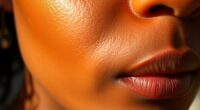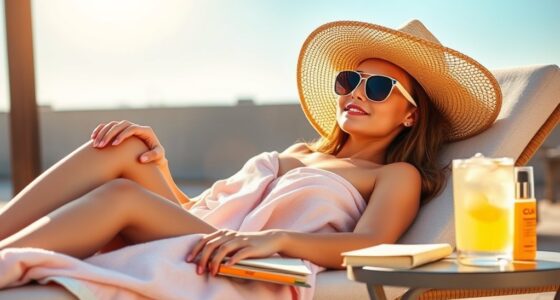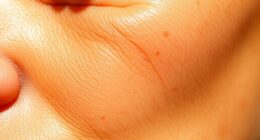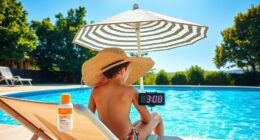Balancing tanning and skin health means understanding that UV exposure, whether from the sun or indoor tanning beds, increases your risk of skin damage, aging, and cancer. While a little sun helps your body produce vitamin D, too much accelerates wrinkles, sagging, and mutations. Protecting your skin with safe habits like seeking shade, wearing hats, and limiting tanning bed use is essential. Stay informed about your skin type and safe practices—your skin will thank you later.
Key Takeaways
- Excessive tanning damages DNA, accelerates skin aging, and significantly increases skin cancer risk, emphasizing the importance of moderation.
- Safe sun exposure (10-30 minutes midday) supports vitamin D production without risking skin damage.
- Using high SPF sunscreen, protective clothing, and seeking shade helps balance tanning benefits with skin health.
- Indoor tanning poses greater risks than natural sunlight, including higher UVA exposure and increased melanoma risk.
- Public awareness and personalized protection strategies are essential for maintaining skin health while enjoying sun exposure.
Understanding the Risks of Tanning and Skin Damage
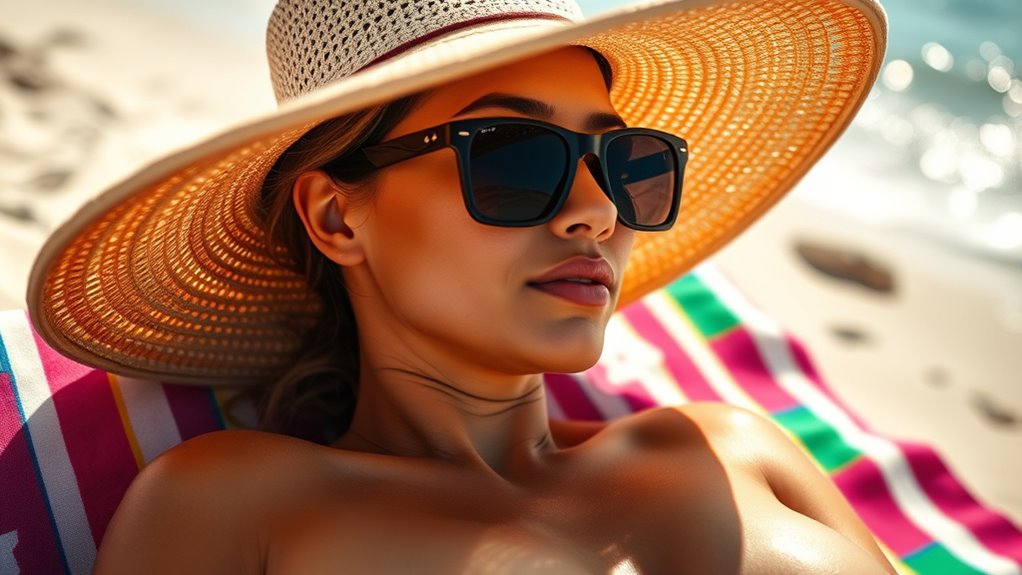
Have you ever wondered if tanning is truly safe? The truth is, it isn’t. Tanning increases your risk of skin cancers like melanoma, basal cell, and squamous cell carcinoma. UV exposure damages your DNA, and this damage adds up from your very first tan. There’s no such thing as a safe tan; all skin darkening results from damage. Indoor tanning is especially dangerous, raising melanoma risk by 75% before age 35. Plus, the melanin your skin produces during tanning only offers an SPF of 2-4, far below the recommended SPF 15. Even brief exposure causes damage that accumulates over time. Understanding cloud services and their vulnerabilities underscores the importance of protecting your skin from harmful UV rays, as the damage is often irreversible. So, if you’re aiming for a tan, know that it comes with serious health risks, and protecting your skin is essential.
The Impact of UV Exposure on Skin Aging and Cancer

Ultraviolet (UV) radiation markedly accelerates skin aging and increases the risk of skin cancer through multiple damaging mechanisms. UV exposure activates MMP enzymes that break down collagen and elastin, leading to wrinkles and sagging. It also generates reactive oxygen species, causing oxidative stress that damages cells and impairs repair. UV-induced DNA mutations disrupt skin cell function, contributing to loss of elasticity and pigmentation changes. Chronic UV exposure thins the epidermis and reduces collagen, worsening skin fragility. Additionally, research on the diverse roles of actors emphasizes the importance of AI safety measures in developing effective sun protection technologies and educational tools. Furthermore, advances in mobile device processing power and AI-driven algorithms are being utilized to improve skin cancer detection and educate the public on UV safety. For example, personalized skin care recommendations based on individual risk factors are increasingly being integrated into prevention strategies. Increased public awareness about the impact of UV on skin health is essential for encouraging protective behaviors and reducing long-term damage.
Indoor Tanning: Myths, Risks, and Realities

Indoor tanning is often misunderstood, with many believing it’s safer or less risky than natural sun exposure, but the facts tell a different story. Tanning beds emit about 12 times more UVA rays than sunlight, which penetrate deeper into your skin and increase cancer risk. Many think a base tan prevents burns, but that’s false—DNA damage and burns can occur regardless. Using tanning beds before age 20 raises melanoma risk by 47%, and just one visit can considerably increase your chances of developing deadly skin cancer. They also accelerate skin aging and cause injuries like burns and eye damage. No spectrum or dose of UV from tanning beds is safe. UV exposure from tanning beds can also lead to other skin issues such as hyperpigmentation and uneven skin tone. Indoor tanning is linked to an increased risk of skin cancers, including melanoma, basal cell carcinoma, and squamous cell carcinoma, which underscores the importance of understanding the associated risks. Additionally, refrigerant leaks and mechanical failures in tanning equipment can contribute to safety hazards, emphasizing the need for proper maintenance and regulation. Recognizing that tanning bed safety measures are often inadequate further highlights the importance of avoiding indoor tanning altogether. Moreover, UV radiation can cause long-term damage to skin cells, making prevention even more critical.
Vitamin D: Benefits, Sources, and Safe Levels of Sun Exposure

While avoiding the risks associated with indoor tanning, you can still obtain essential vitamin D through safe sun exposure and dietary sources. UVB radiation from sunlight triggers your skin to produce vitamin D3 from 7-dehydrocholesterol, supporting skin barrier function and keratinocyte health. Typically, 80-90% of your vitamin D comes from sun exposure. To minimize photoaging, aim for 10-30 minutes of midday sun (10 a.m. to 3 p.m.) a few times weekly, exposing arms and legs rather than the face or neck. Remember, SPF15+ sunscreen blocks vitamin D synthesis. You can also boost your levels through foods like fatty fish and fortified dairy, or supplements. Maintaining blood vitamin D levels between 30-50 ng/mL helps maximize skin benefits without risking damage. Juice recipes and mixes can provide additional nutrients that support skin health and overall well-being. Incorporating proper sun safety practices is essential to balance vitamin D production with skin protection. Additionally, understanding your vitamin D needs can help tailor safe sun exposure and dietary strategies effectively. Regularly monitoring your vitamin D levels can ensure you maintain optimal health and skin function.
Recognizing Skin Types and Their Unique Vulnerabilities
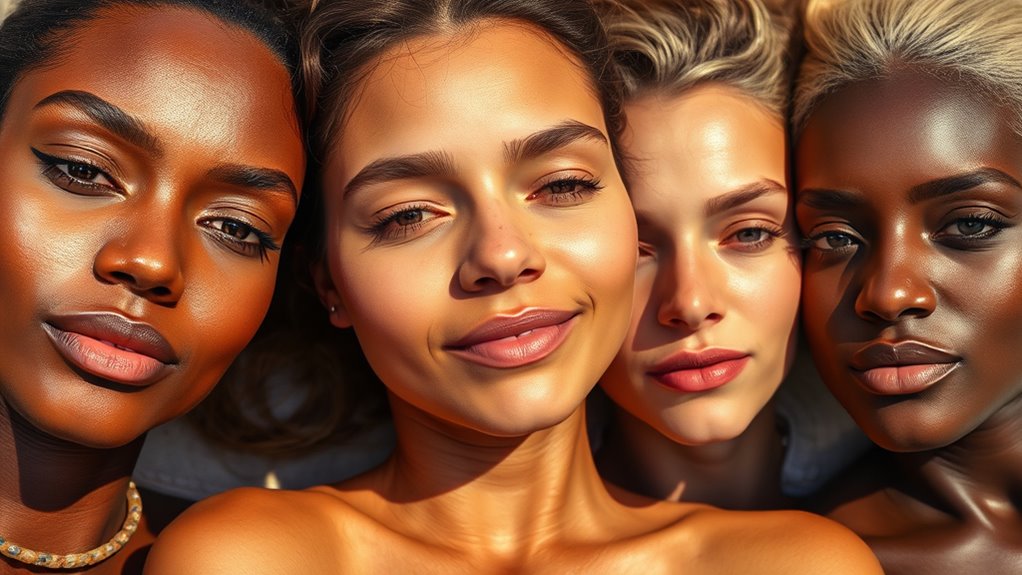
Understanding your skin type is essential for tailoring effective sun protection and skincare routines. The Fitzpatrick classification helps identify your UV response, from Type I, which burns easily and never tans, to Type VI, which rarely burns and has high melanin. Fair skin types (I and II) are more vulnerable to sunburn, photoaging, and skin cancer, requiring diligent sunscreen use and protective clothing. Proper sun protection is vital for these sensitive skin types. Darker skin types (V and VI) have natural UV protection but can still suffer UV damage, hyperpigmentation, and delayed cancer detection. Skin moisture and oil balance also influence vulnerability—dry or sensitive skin may react more to environmental factors, while oily skin can trap irritants. Recognizing these differences helps you adopt personalized strategies for safer sun exposure and skin health. Additionally, gear shifting techniques on a bike can help prevent sudden accidents during outdoor activities. Moreover, staying informed about data privacy challenges and emerging technologies can help you make better choices regarding your personal information and health data.
Safe Alternatives to Achieve a Tanned Look
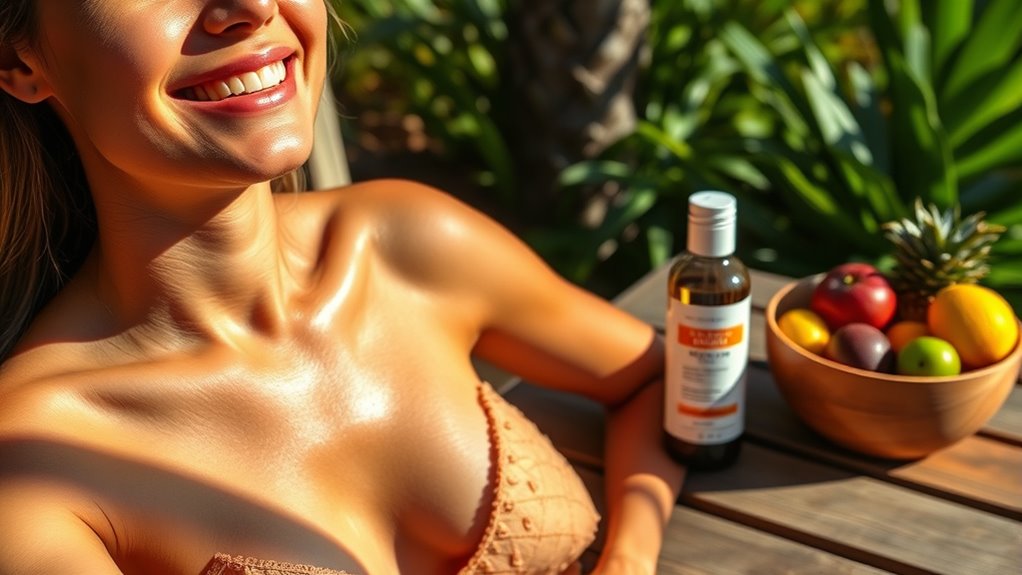
Achieving a sun-kissed glow without the risks of UV exposure is increasingly popular, thanks to a variety of safe, effective alternatives. Spray tanning uses dihydroxyacetone (DHA) to darken your skin temporarily without UV rays. You can choose professional booth sprays, at-home mousses, or wipes for even application, but wearing a mask during application is recommended to prevent DHA inhalation. DHA-based self-tanners, approved by the FDA, produce color within 2-8 hours and often include hydrating ingredients like aloe. Non-toxic products, free from parabens and sulfates, use botanical ingredients such as shea butter, making them suitable for sensitive skin and children. Remember to exfoliate before application to prevent uneven fading, and wash hands promptly to avoid staining.
Empowering Public Awareness and Promoting Sun Safety
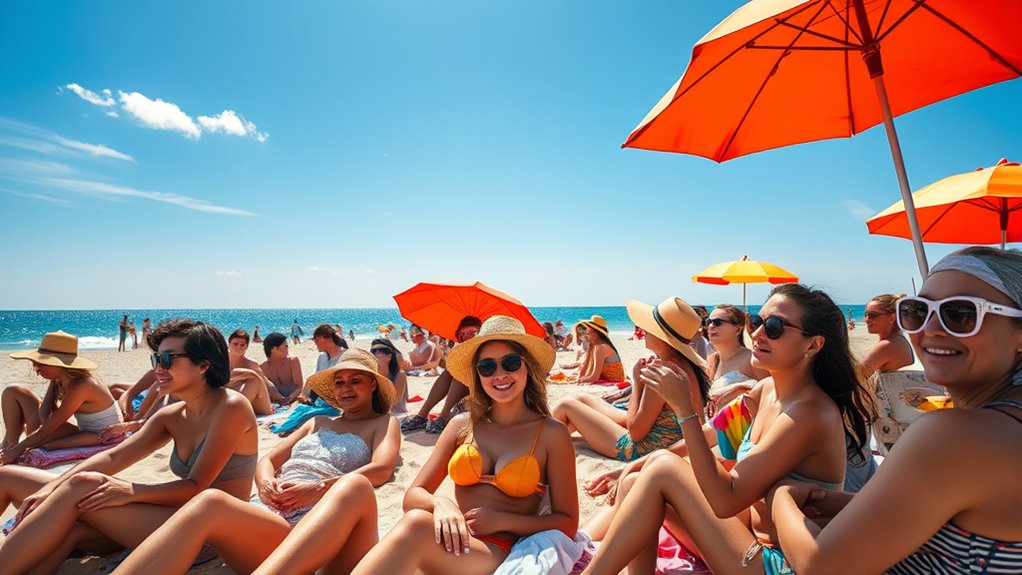
Raising public awareness about sun safety is essential to reducing skin cancer risks, as many people remain unaware of how UV exposure affects their health. Despite knowing the dangers, many don’t consistently practice sun protection. Public health campaigns, national awareness days, and community efforts are key to bridging this gap. Media and digital platforms help spread messages about the importance of shade, hats, and sunscreen. Engaging communities can improve collective understanding and motivate healthier behaviors. Surveys show that while awareness has increased, actual protection practices still lag, especially among youth and underserved populations. Additionally, public health initiatives play a crucial role in educating individuals about proper sun safety measures. By emphasizing the preventability of skin cancer and promoting simple, accessible actions, you can help foster safer habits and reduce the long-term impact of harmful UV exposure. Incorporating behavior change strategies can further enhance the effectiveness of these campaigns and encourage lasting protective habits. Recognizing the importance of risk assessment can help tailor messages to specific populations and improve intervention outcomes. Educating people about the types of UV radiation and their effects can empower them to take more effective protective measures. Furthermore, understanding the differing sensitivities to UV exposure among various skin types can help develop more personalized sun safety advice.
Practical Strategies for Balancing Vitamin D Needs and Skin Health

Balancing your need for vitamin D with skin health requires mindful sun exposure practices, as both are closely linked. To produce enough vitamin D, aim for short, daily sun exposure during peak hours, but avoid prolonged exposure that increases skin damage risk. If you have darker skin tones, you may need slightly more sun, so adjust accordingly. Living near the equator makes vitamin D synthesis easier year-round, but those farther away should consider seasonal adjustments. Incorporate vitamin D-rich foods like mushrooms and fortified products into your diet, and consider supplements if needed. Manage clothing and sunscreen use carefully—some sun exposure is necessary for vitamin D, but protect your skin from overexposure. Regularly monitor your vitamin D levels and adapt your habits to maintain a healthy balance. Practicing mindful sun exposure can also help prevent skin damage while supporting your overall well-being humor in divorce.
Frequently Asked Questions
Can Tanning Beds Ever Be Safe With Proper Precautions?
You might wonder if tanning beds can ever be safe with precautions, but the truth is, they can’t. Even with goggles, limited sessions, and proper positioning, UV rays still cause irreversible skin damage and increase your cancer risk. Medical experts agree there’s no safe level of UV exposure from tanning beds. Instead, consider sunless alternatives like self-tanning products to achieve a tan without harming your skin or health.
How Does Sunscreen Influence Vitamin D Production?
Sunscreen can slightly reduce your vitamin D production because it blocks UVB rays necessary for synthesis. However, in real life, perfect application is rare, and small amounts of UVB still reach your skin, so your vitamin D levels typically stay stable. Just 10-15 minutes of sun exposure a few times a week, even with sunscreen, is usually enough. For safety, consider dietary sources or supplements if you’re at risk of deficiency.
Are There Genetic Factors That Affect Skin Cancer Risk?
You should know that genetic factors do influence your skin cancer risk. Certain genes like *CDKN2A*, *CDK4*, *MITF*, and *BAP1* can increase your likelihood of developing melanoma, especially if there’s a family history. While genetics play a role, lifestyle factors like sun exposure are more common contributors. If you have a family history, consider genetic testing and regular screenings to catch risks early and protect your skin health.
What Are the Long-Term Effects of Repeated Tanning Bed Use?
Repeated tanning bed use isn’t just a minor habit; it’s like slowly turning your skin into a ticking time bomb. Over time, you’ll face accelerated aging with wrinkles, leathery texture, and uneven pigmentation. Your risk of skin cancers skyrockets, including melanoma, with each session adding damage. Expect to suffer from eye injuries, immune suppression, and even premature cataracts. The long-term effects are a steep price for a fleeting glow.
How Effective Are Self-Tanning Products Compared to Natural Sun Exposure?
Self-tanning products are effective for giving you a tan without UV exposure, but they don’t provide any sun protection. They work by chemically reacting with your skin’s surface, creating a temporary darker color. Unlike natural sun exposure, they don’t stimulate melanin production or offer any defense against UV rays. To stay safe, you should still use sunscreen and limit direct sun exposure even when you have a self-tan.
Conclusion
Finding the balance between enjoying the sun and protecting your skin is like walking a tightrope—you need awareness and care. By understanding the risks, recognizing your skin type, and exploring safe alternatives, you can bask in the sun’s benefits without falling into harm’s way. Remember, your skin’s health is your greatest asset; treat it with kindness and respect, so it can glow with beauty and resilience for years to come.

